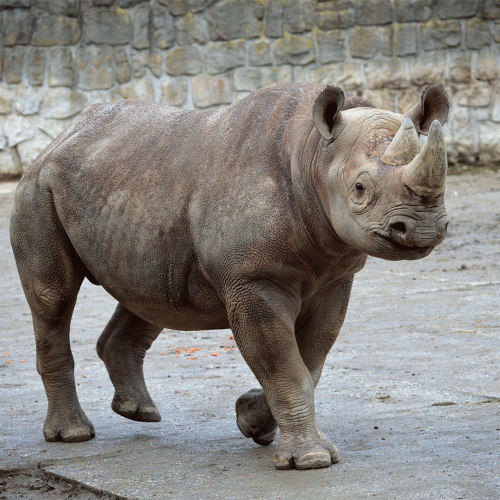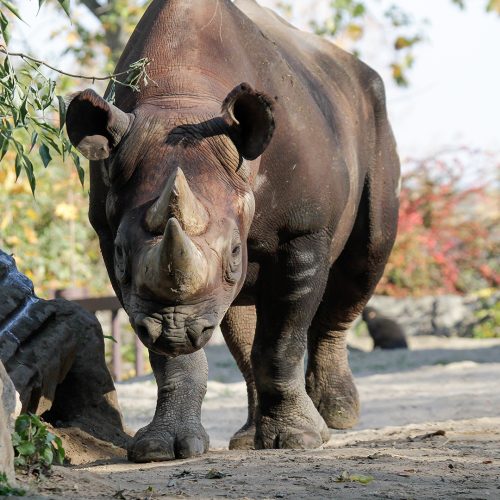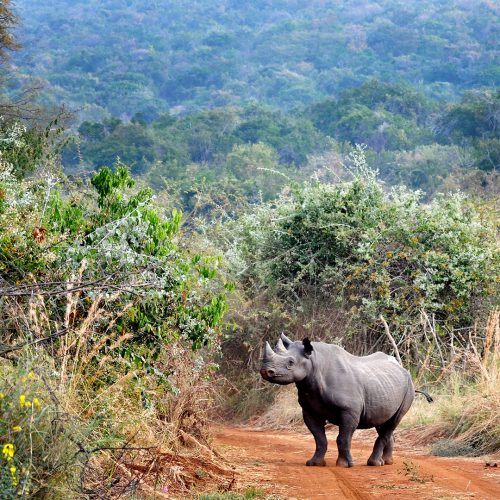The Eastern black rhino population in Rwanda’s Akagera National Park has grown with the arrival of five new individuals from European zoos, as part of the largest ever translocation of rhinos from Europe to Africa.

The move is part of a major international collaboration overseen by our conservationists.
CEO, Dr Mark Pilgrim, who manages the population of Eastern black rhino across European zoos, said:
“This is a historic moment for eastern black rhino conservation. Black rhino populations have dropped by more than 95% in Africa over the last 100 years due to a global surge in illegal poaching for their horns. Just 12 years ago, they completely disappeared in Rwanda where they were declared extinct.
“To now be part of a successful reintroduction of eastern black rhinos back to Rwanda, with individuals from the healthy, thriving and genetically viable population in zoos in Europe, is a dream come true – and a huge boost to the future of this iconic species.
PSSSTT
“This is a major moment for zoos and for wildlife conservation. The future of eastern black rhinos could depend on it.”
The historic translocation was undertaken by the European Association of Zoos and Aquaria (EAZA), the Rwanda Development Board (RDB) and African Parks, which manages Akagera National Park in partnership with the RDB.
Two male and three female rhinos were released into bomas (temporary enclosures) in Akagera, with the aim of increasing the genetic diversity of the park’s rhino population and aiding efforts to restore the critically endangered subspecies in Rwanda and the region.
Jes Gruner, Park Manager of Akagera National Park, said:
PSSSTT
“The newly translocated rhinos will bolster the founder group that we introduced in 2017, contributing to the reestablishment of a robust Eastern black rhino population in Rwanda.”
“This unique achievement represents the culmination of an unprecedented international effort to improve the survival prospects of a critically endangered rhino subspecies in the wild. Their arrival also marks an important step in Akagera’s ongoing revitalization, and one that underscores the country’s commitment to conservation.”
Originally hailing from Safari Park Dvůr Králové (Czech Republic), Flamingo Land (United Kingdom) and Ree Park Safari (Denmark), they were selected from the EAZA Ex Situ Programme (EEP) for Eastern black rhino, managed by conservationists at Chester Zoo.
One of the rhinos, ‘Mandela’, is the offspring of mum ‘Bashira’ who was born at Chester Zoo as part of the breeding programme.
The five rhinos began their journey from the Czech Republic following months of preparation at Safari Park Dvůr Králové. Every precaution was taken to minimize stress and ensure their well-being throughout the translocation process. They were flown to Kigali before being transferred to Akagera National Park by truck.
All five Eastern black rhinos were then released into enclosures in the park where they will remain for at least three weeks to ensure they have time to acclimatize to their new environment. Once they have adjusted, they will be released into a 10-hectare sanctuary where they will continue to be closely monitored for several months as they establish themselves in the area before being released into the wider park.

Clare Akamanzi, CEO of the Rwanda Development Board, said:
“We are committed to the long-term success of Eastern Black Rhinos in Rwanda. Their health and well-being is crucial to wildlife conservation and biodiversity protection efforts, both in Rwanda and across Africa. We couldn’t be prouder of the strong community-led conservation efforts that make their new home, Akagera National Park, one of the most vibrant and spectacular Big Five Parks in the region, and we are sure that the Park’s newest residents will settle in well. Tourists visiting Akagera National Park will get to witness a truly wonderful sight, the Eastern black rhino in its natural habitat.”
Akagera National Park, a protected savannah habitat in Rwanda that contains excellent black rhino habitat, has undergone a remarkable transformation since African Parks assumed management in 2010 in partnership with the Rwanda Development Board. In 2017, ten years after Eastern Black Rhinos had last been seen in Akagera, the species was reintroduced with the translocation of 18 individuals from South Africa through a project supported by the Howard G. Buffett Foundation.
The founder population that now numbers 20 adapted well, demonstrating the park’s potential to sustain a black rhino population while underscoring the extremely high levels of security and effective park management provided by African Parks and the Government of Rwanda. Just under a decade of management with improved law enforcement and strong community and economic development initiatives has seen poaching practically eliminated, key species including lion and rhino returned, significant support fostered for conservation, and vibrant tourism leading to Akagera being 80% self-financing.
The long-term viability and genetic health of Rwanda’s Eastern black rhino population requires the introduction of additional animals. The five newly translocated individuals—two males and three females whose ages range from two to nine—were carefully selected and result from the foresight and vision of EAZA in helping to supplement wild populations in secure parks in Africa with genetically-robust individuals successfully bred and nurtured by the EEP.

Dr. Thomas Kauffels, Chair of the European Association of Zoos and Aquaria, said:
“The success of the EEP has enabled us to supplement natural populations of rhinos in Africa,” “Modern zoos are a key part of the conservation landscape, and our collaboration with Akagera National Park and the Rwanda Development Board demonstrates how zoos can contribute directly to the conservation and recovery of endangered species in protected landscapes.”
Extensive security measures have been implemented to ensure the long-term safety and well-being of Akagera’s rhinos. They include an expertly trained rhino tracking and protection team put in place in 2017, a canine anti-poaching unit, and the deployment of a helicopter for critical air surveillance to enhance protection of the park – all made possible with funding provided by the Howard G. Buffett Foundation.
Black rhinos are considered critically endangered by the International Union for Conservation of Nature (IUCN), with fewer than 5,000 black rhinos remaining across their range in the wild, and of these approximately 1,000 are the critically endangered Eastern black subspecies. This translocation, which is being carried out according to IUCN guidelines, represents an urgent and valuable opportunity to expand the range of the black rhino with the help of zoo-bred rhinos to supplement and repopulate wild populations. It also forms part of the Government of Rwanda’s vision to revitalize and protect its natural heritage to create a future in which both people and wildlife can thrive.
Photo credit: Scott Ramsay
EVERY DAY 3 RHINOS ARE POACHED FOR THEIR HORNS FOR USE IN THE ILLEGAL WILDLIFE TRADE
90% of the black rhino population has decreased over the last three generations, due to poaching. Poachers are ruthless and will stop at nothing to get their hands on rhino horn thanks to the demand on the black market for medicines and ornaments.
We’re FIGHTING for the survival of eastern black rhinos
We’re proud to be working with the rhino rangers and game scouts who are on the frontline of the war against illegal wildlife trade – these conservation heroes risk their lives daily to save this incredible animal.
Found out more about how we’re acting for eastern black rhinos